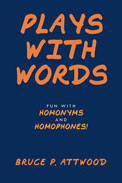
 |
This celebration of homophones and homonyms revels in wordplay and invites laughs and groans in equal measure. Attwood turns the sometimes maddening confusion of homophones and homonyms into an opportunity for storytelling and joy. Many teachers, students, and English language learners have seen up close the struggle that can ensue over the mastery of these words. Attwood admirably steps in and uses the spark of words to create vignettes built on sequences of homophones and homonyms. The brief stories vary in length and subject matter and are driven by the wordplay. Attwood manipulates situations and sentences like building blocks, constructing a maze that zigs and zags until the homophones come together with a final flourish.
The author appears to be having a great deal of fun with this collection, and his infectious spirit buzzes on every page. He is part entertainer and part wordsmith, looking for laughs and showcasing words. In his command, the English language is molded and shaped to fit his creative flair. His wordplay strays close to puns, which also use homophones and homonyms for easy jokes or rhetorical effect. With wit and enthusiasm, Attwood unleashes the homophones and homonyms to roam through his stories. He builds them up, sets them in a scene, then stands back for the joke to land.
Like a stand-up comedian, Attwood works the crowd with a full commitment to unload the joke and wait for the laugh. You can almost hear these stories being told aloud in the cadence and style of a man on stage at the comedy club. In print, they still manage to convey humor and playfulness, the joy and malleability of language. He is devoted to the challenge of working these homophones into a sequence that makes sense, is meaningful, and satisfies the ending of a story.